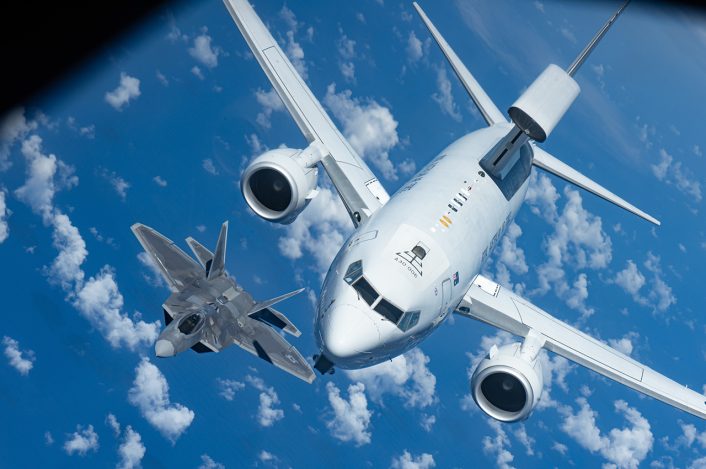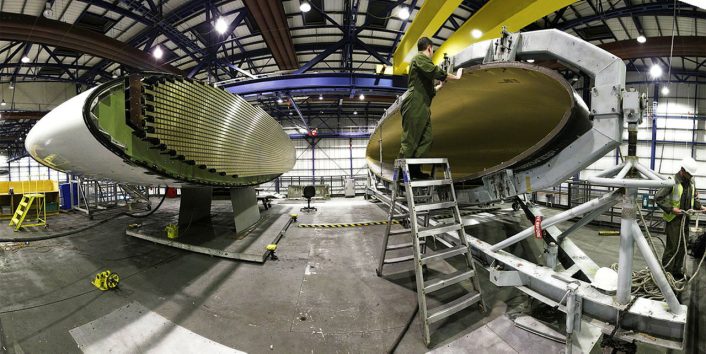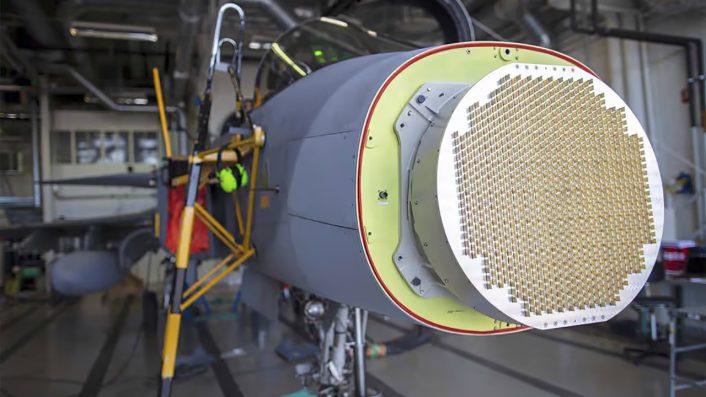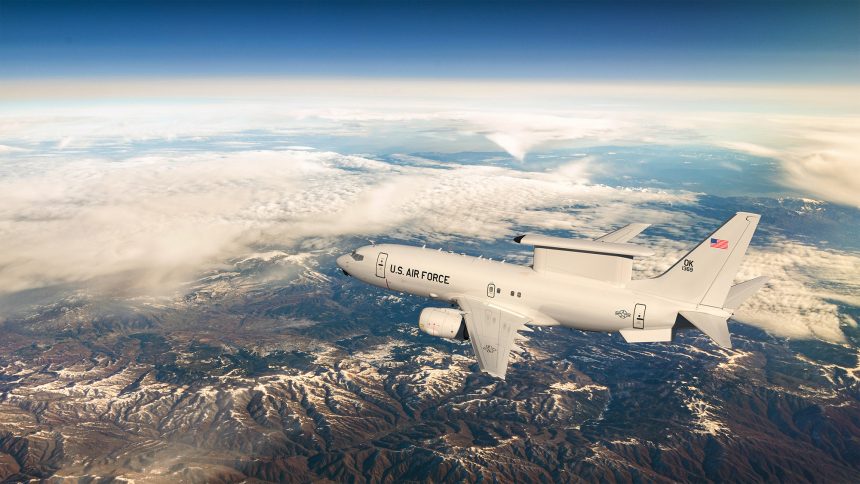Even before delivery, new technologies are being investigated for possible integration on the USAF’s future E-7 Wedgetail fleet – including a replacement for the aircraft’s distinctive radar.
Following the procurement announcement in 2022, production of the U.S. Air Force’s first E-7A Wedgetail airborne early warning & control (AEW&C) aircraft is now well underway. The fuselage of the first airframe, which will be used as a rapid prototype as part of the initial contract for two aircraft, arrived at Boeing’s Renton facility for assembly in January of this year.
Although the type’s entry to service is likely still a number of years away, the U.S. Air Force is already eyeing potential upgrades for the now 20 year old design. Along with updates to the platform’s electronic warfare, communications, and datalinking capabilities, the service is also investigating the integration of an infrared sensor and a replacement for the Northrop Grumman Multi-role Electronically Scanned Array (MESA) radar. The full list of desired technology upgrades described by the request for information (RFI) can be found here, and is repeated below:
Advanced sensor (MESA replacement)
Advanced Infrared sensor
Electronic Support Measures (ESM) replacement
Electronic Warfare Self-Protection (EWSP) replacement
Tactical Targeting Network Technology (TTNT)
Link 16 High Power Amplifier (HPA)
Joint Worldwide Intelligence Communications System (JWICS) connectivity
Combat Identification (CID)
Next-generation Tactical Data Link (TDL)
Advanced missile data link capabilities, and other next-generation AMTI,
Battle Management /Command and Control (BMC2)
Alternative Position, Navigation, and Timing, and/or communications technologies
An Engineering and Manufacturing Development (EMD) contract based on the RFI is expected to follow in the 2027 financial year. The Air Force will consider retrofitting the technologies onto existing E-7 airframes, integrating them onto newbuild airframes, or a combination of these two options.

A total of 26 E-7 airframes are included in the USAF’s planned procurement schedule, which will deliver a smaller fleet than that of the E-3 Sentry being replaced. The decision to buy the Wedgetail has frequently been described as a stopgap measure which will cover the gap between what are considered legacy AEW solutions and emerging technologies that will make use of unmanned aircraft and even space-based platforms.
With the growing vulnerability of crewed AWACs platforms – is it time to move AEW to space? ‘In the latest issue of AEROSPACE – February 2024’ #avgeek #SGAirShow2024 https://t.co/ngDWb22DzR pic.twitter.com/G7vE5OuVbZ
— Royal Aeronautical Society (@AeroSociety) January 30, 2024
Current and future overseas operators of the Wedgetail, including original customer Australia, will likely look at any upgrades made to USAF airframes with a view to integrate them on their own airframes. Having the massive resources and spending power of the U.S. Air Force behind the aircraft is also certain to help entice more customers to adopt the E-7.
The MESA Radar
Wedgetail’s dorsally mounted radar array, referred to as the ‘top hat’, is the E-7’s most distinctive feature and also illustrates a major difference in radar technology between it and previous AEW&C aircraft like the E-3 Sentry. The E-3 and other similar aircraft’s rotating radomes remain iconic but are the product of now dated radar technologies.

The E-3 Sentry, depending on variant, uses the AN/APY-1 and AN/APY-2 radars. These are based on early developments in electronically scanned radars, and use passive electronically scanned arrays (PESA). However, the electronic steering of these radars is limited to the vertical up-down axis. To provide 360 degree horizontal coverage, the radar is mechanically steered by rotating the entire radome up to six times per minute.
These radars form part of the Airborne Warning and Control System (AWACS). Although commonly used to describe the AEW&C role in general, AWACS is actually a specific Boeing-produced system used only by the E-3 Sentry and the E-767.
With the E-7’s MESA, a modern active electronically scanned array (AESA) radar, all radar steering is accomplished through electronic means. In addition, as AESA radars use individual transmit/receive modules for each element in the antenna, instead of acting as one single ‘beam’ the radar can be separated into many independently steerable beams. A popular video shared across social media describes the difference with a comparison between a lighthouse’s beam, and a concert light show with hundreds of moving head lights. Though simplified, it works as a fairly accurate analogy.
A PESA has only one transmitter linked into the attennae array through phase shifters. In an AESA each attenna element has a transmitter/ receiver module. This allows incredible flexibility: Multiple beams of different frequencies in different directions, simultaneously. pic.twitter.com/vcfLzIHoxl
— Jordan Taylor (@Jordan_W_Taylor) September 6, 2023
These antennas are arranged on a flat surface, meaning although they can scan horizontally and vertically their field of view is still directionally limited. To overcome this, instead of rotating the entire radar assembly, the MESA uses multiple radar faces to face each direction. The two primary faces – called side-emitting electronic manifold arrays – are actually located on each side of the rectangular fairing that supports the wider top hat section. These cover a field of view of 120 degrees to the aircraft’s port and starboard sides.
Fore and aft coverage is provided by an ‘end firing’ array located in the top hat section itself. This allows 60 degrees of coverage in each direction, allowing constant scanning across 360 degrees of airspace.

It should be noted that mechanical scanning, either by rotating or directing the radar face, can still be used in conjunction with modern PESA and AESA radars. The E-2D Hawkeye’s AN/APY-9 radar combines a specially designed AESA array, tailored to fit the existing E-2 design’s airframe and radome, with mechanical rotation to provide 360 degree coverage. A PESA example can be found on the Royal Navy’s Type 45 destroyer, where the SAMPSON radar features two radar faces in a mast-mounted rotating dome. This solution was chosen to allow the radar faces to be mounted as high on the ship as possible, extending the radar horizon for low level targets.
Northrop Grumman EMRIS
Developed by the same company as MESA, the Electronically Scanned Multifunction Reconfigurable Integrated Sensor (EMRIS) would appear to be a natural successor for the radar and will likely be among the solutions considered for the E-7.
EMRIS, announced in 2023, is intended to combine radar, electronic warfare, and communications into one single multi-role system. Northrop Grumman say versions of the system have already been flight tested, and work is underway on the production of scaled-down versions which can be integrated on smaller weight-limited platforms.
Very few other details have been released regarding EMRIS. We know that it is based on an AESA radar and will take advantage of modern developments in systems architectures, rapid prototyping, and cost-effective production, but we do not know which type or types of aircraft were utilized in testing.









